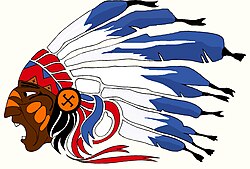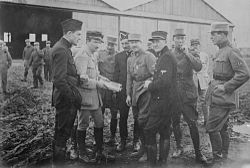| Escadrille 124 | |
|---|---|
 Squadron Insignia of the Lafayette Escadrille | |
| Active | 1916 |
| Country |
|
| Branch | French Air Service |
| Type | Fighter Squadron |
The Lafayette Escadrille (from the French Escadrille de Lafayette) was an escadrille of the French Air Service, the Aéronautique Militaire, during World War I composed largely of American volunteer pilots flying fighters.
History[]

Kiffin Rockwell, Capt. Georges Thenault, Norman Prince, Lt. Alfred de Laage de Meux, Elliot Cowdin, Bert Hall, James McConnell and Victor Chapman (left to right)
Dr. Edmund L. Gros, director of the American Ambulance Service, and Norman Prince, an American expatriate already flying for France, led the efforts to persuade the French government of the value of a volunteer American air unit fighting for France. The aim was to have their efforts recognized by the American public and thus, it was hoped, the resulting publicity would rouse interest in abandoning neutrality and joining the fight. Authorized by the French Air Department on March 21, 1916, the Escadrille Américaine (Escadrille N.124) was deployed on April 20 in Luxeuil-les-Bains, France. Despite their slow progress with public popularity in America, the squadron proved the benefits of aerial combat to both sides. Before World War I, planes were not considered instruments of combat.
Not all American pilots were in Lafayette Escadrille; other American pilots fought for France as part of the Lafayette Flying Corps.[N 1]
The squadron was then moved closer to the front to Bar-le-Duc. A German objection filed with the U.S. government, over the actions of a supposed neutral nation, led to the name change to Lafayette Escadrille in December 1916, as the original name implied that the U.S. was allied to France rather than neutral.[1]
The unit's aircraft, mechanics, and uniforms were French, as was the commander, Captain Georges Thenault. Five French pilots were also on the roster, serving at various times. Raoul Lufbery, a French-born American citizen, became the squadron's first, and ultimately their highest scoring flying ace with 16 confirmed victories before the pilots of the squadron were inducted into the U.S. Air Service.
Combat[]

Lafayette Escadrille banner.
The first major action seen by the squadron was 13 May 1916 at the Battle of Verdun and five days later, Kiffin Rockwell recorded the unit's first aerial victory.[1] On June 23, the Escadrille suffered its first fatality when Victor Chapman was shot down over Douaumont.[1][2] The unit was posted to the front until September 1916, when the unit was moved back to Luxeuil-les-Bains in 7 Army area. On September 23, Rockwell was killed when his Nieuport was downed by the gunner in a German Albatross observation plane[3] and in October Norman Prince was shot down during battle. The squadron, flying the Nieuport 11 scout, suffered heavy losses, but its core group of 38 was rapidly replenished by other Americans arriving from overseas. So many volunteered that the Lafayette Flying Corps was formed and many Americans thereafter serving with other French air units such as Michigan's Fred Zinn, who was a pioneer of aerial photography, fought as part of the French Foreign Legion and later the French Aéronautique militaire. Altogether, 265 American volunteers served in the Corps.
On 8 February 1918, the squadron was disbanded and 12 of its American members inducted into the Air Service as members of the 103rd Aero Squadron. For a brief period it retained its French aircraft and mechanics. Most of its veteran members were set to work training newly arrived American pilots. The 103rd was credited with a further 45 kills before the Armistice went into effect on November 11.
Members[]
James Norman Hall (1887–1951) of the Lafayette Escadrille, 1917
There is some confusion between pilots who were a part of the Lafayette Escadrille or the Lafayette Flying Corps, especially in the film Flyboys. These five French officers and 38 American pilots (also known as "The Valiant 38") were part of the Lafayette Escadrille.[4]
French officers[]
- Capt. Georges Thenault
- Lt. Alfred de Laage de Meux
- Lt. Charles Nungesser
- Lt. Antoine Arnoux de Maison-Rouge
- Lt. Louis Verdier-Fauvety
American pilots[]
A † symbol indicates that the individual was killed in action, including as those who subsequently entered the Air Service, or died of wounds received
- Horace Clyde Balsley
- Stephen Sohier Bigelow
- Ray Claflin Bridgman
- Andrew Courtney Campbell, Jr.†
- Victor Emmanuel Chapman†
- Elliott Christopher Cowdin
- Charles Heave Dolan
- James Ralph Doolittle†
- John Armstrong Drexel
- William Edward Dugan, Jr.
- Christopher William Ford
- Edmond Charles Clinton Genet†
- James Norman Hall
- Bert Hall
- Willis Bradley Haviland
- Thomas Moses Hewitt, Jr.
- Dudley Lawrence Hill
- Edward Foote Hinkle
- Ronald Wood Hoskier†
- Charles Chouteau Johnson
- Henry Sweet Jones
- Walter Lovell
- Raoul Lufbery†
- James Rogers McConnell†
- Douglas MacMonagle
- Kenneth Archibald Marr
- Didier Masson
- Edwin C. "Ted" Parsons
- Paul Pavelka†
- David M. Peterson
- Frederick Henry Prince, Jr.
- Norman Prince†
- Kiffin Yates Rockwell†
- Robert Lockerbie Rockwell
- Laurence Dana Rumsey, Jr.
- Robert Soubiran
- William Thaw
- Harold Buckley Willis
Tributes[]

Lafayette Escadrille Memorial Arch, 1928
- Lafayette Escadrille Memorial, Villeneuve-l'Étang Imperial Estate, in Marnes-la-Coquette, Hauts-de-Seine, outside of Paris, France, the final work of French architect Alexandre Marcel, 1928
- Memorial to the American Volunteers. On 4 July 1923, the President of the French Council of State, Raymond Poincaré, dedicated a monument in the Place des États-Unis, Paris, to the Americans who had volunteered to fight in World War I in the service of France.
- A statue by the sculptor Gutzon Borglum titled The Aviator (1919) was erected on the grounds of the University of Virginia in Charlottesville, Virginia in the memory of James R. McConnell, who was killed during the War.
- Two other memorials are dedicated to McConnell and located in Carthage, North Carolina. The first is a granite column flanked by two cannon, the other is a granite stone inscribed in French at the community house.

Community House Monument to James R. McConnell
- Norman Prince tomb, Washington National Cathedral, Washington, D.C.
- There is a plaque in the memory of Kiffen Yates Rockwell in Lee Chapel at Washington & Lee University in Lexington, Virginia, the college Rockwell attended before the war.
Fictional accounts[]
The story of the Lafayette Escadrille has been depicted in three feature films: The Legion of the Condemned (1928) a William A. Wellman film; Lafayette Escadrille (1958), a Wellman film starring Tab Hunter, and Flyboys (2006), directed by Tony Bill and starring James Franco. The Lafayette Escadrille also appears in "Attack of the Hawkmen", an episode of The Young Indiana Jones Chronicles in which Indy is temporarily assigned to the group as an aerial reconnaissance photographer.
The exploits of the Lafayette Escadrille are also captured in several works of historical fiction including: Falcons of France by Charles Nordhoff and James Norman Hall (1929) and To the Last Man by Jeffrey Shaara .
Rif War[]
In the mid-1920s, France recruited some 10 former pilots of the Lafayette Escadrille for service in the French Army of Africa, aiming to forestall American public and diplomatic support for the Rif tribes rebelling against French and Spanish colonial rule. The pilots were inducted into the French Foreign Legion in July 1925, where they formed the Chérif Squadron. Public protests in the United States led to the squadron's dissolution in 1925.
See also[]
- List of World War I flying aces
- Eagle Squadron—American volunteers in the RAF during World War II
- Flying Tigers—American volunteers who fought for the ROC in the Sino-Japanese War
- Kościuszko Squadron—American volunteers fighting for Poland in the Polish-Soviet War (1919–1921)
- Vintage Aero Flying Museum artifact collection
References[]
Notes[]
- ↑ Compared to the Lafayette Escadrille, larger numbers of American volunteers served with the Royal Flying Corps, Royal Naval Air Service and Royal Air Force during World War I.
Citations[]
- ↑ 1.0 1.1 1.2 Duffy, Michael. "Lafayette Escadrille." firstworldwar.com. Retrieved: 20 May 2013.
- ↑ The Story of the Lafayette Escadrille. Told by its Commander, Captain Georges Thenault. Translated by Walter Duranty. Boston: Small, Maynard & Company (1921).
- ↑ "Kiffin Y. Rockwell, World War I Aviator, Lafayette Escadrille: Biography & Photographs." Virginia Military Institute. Retrieved: 20 May 2013.
- ↑ "List of Pilots." pagesperso-orange.fr. Retrieved: 19 August 2010.
Bibliography[]
- Azzou, El-Mostafa. "L'Escadrille Lafayette: Des aviateurs Americains dans la Guerre du Rif (1921-1926) (French)". Guerres Mondiales et Conflits Contemporains, Volume 53, Issue 209, January 2003, pp. 57–63.
- Bowen, Ezra. Knights of the Air. New York: Time Life Books Aviation Series, 1980. ISBN 0-8094-3252-8.
- Brown, Walt, Jr. An American for Lafayette: The Diaries of E.C.C. Genet, Lafayette Escadrille. Charlottesville Virginia: University Press of Virginia, 1981. ISBN 0-8139-0893-0.
- "Lafayette Escadrille." firstworldwar.com, 2009. Encyclopedia Software, 1 March 2011.
- McConnell, James R. "Flying For France: Further Experiences Of An Aviator In The American Escadrille In France". The World's Work: A History of Our TimeXXXIII, March 1917, pp. 497–509. Retrieved: 4 August 2009.
- McConnell, James. "Flying For France: With The American Escadrille At Verdun". The World's Work: A History of Our Time XXXIII, November 1916, pp. 41–53. Retrieved: 4 August 2009.
- Morse, Edwin W. America in the War: The Vanguard of American Volunteers in the Fighting Lines and in Humanitarian Service, August, 1914–April, 1917. New York: Charles Scribner's Sons, 1919.
- Nasuti, Guy. "Motivations of the Lafayette Escadrille Pilots." militaryhistoryonline.com, 2006. Article Software, 1 March 2011.
- Nordhoff, Charles and James Norman Hall. The Lafayette Flying Corps. Boston and New York: Houghton Mifflin Company, 1920.
- Parsons, Edwin C. I Flew with the Lafayette Escadrille. Indianapolis, Indiana: E. C. Seale and Company, Inc., 1930 first edition, reprint 1953.
- Shaara, Jeff. To the Last Man: A Novel of the First World War. New York: The Random House Publishing Group, 2004. ISBN 0-345-46134-7.
- Thenault, Georges. The Story of the LaFayette Escadrille- Told By its Commander Captain Georges Thenault (Translated by Walter Duranty, with An Introduction By Andre Tardieu (High Commissioner of Franco-American Affairs). Boston: Small, Maynard & Company, 1921.
- Wilson, Thomas. Kickapoo. Thomaston, Maine: Dan River Press, 2006. ISBN 978-0-89754-216-6.
External links[]
- The Story of the Lafayette Escadrille. Told by its Commander, Captain Georges Thenault. Translated by Walter Duranty. Boston: Small, Maynard & Company (1921).
- Lafayette Pilots' Memorial
- James McConnell's book, Flying in France
- History of the Escadrille
- New England Air Museum's Lafayette Escadrille Online Exhibit
- Query regarding Lafayette Escadrille & Lafayette Flying Corps
- Motivations of the Lafayette Escadrille Pilots by Guy Nasuti
- Valiant Volunteers by Terry Johnson
- Philippe D. Rogers, L'escadrille Lafayette : unité de combat volontaire oubliée de l'Amérique English version
- Philippe D. Rogers, L'escadrille Lafayette : unité de combat volontaire oubliée de l'Amérique Version française
- Kickapoo by Thomas Wilson
- American Aviation during World War I
- Over the Front WWI Aviation Magazine
| ||||||||||||||
The original article can be found at Lafayette Escadrille and the edit history here.